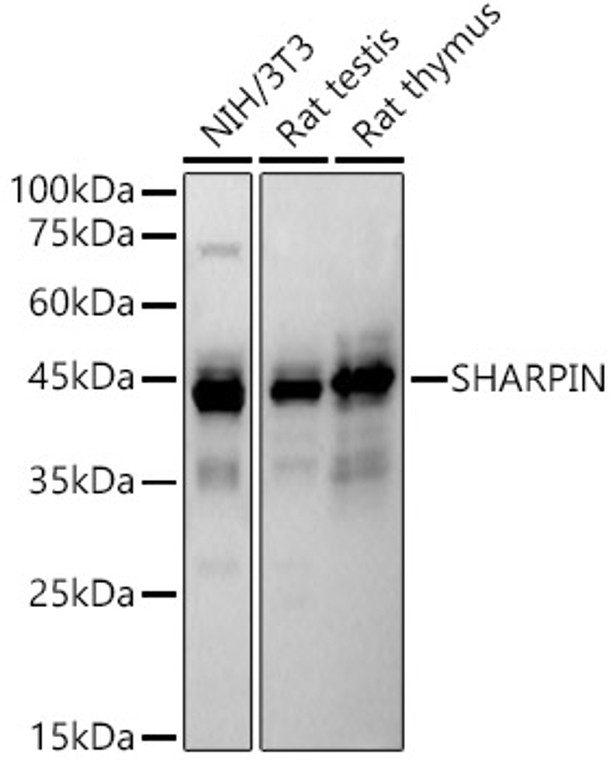| Host: |
Rabbit |
| Applications: |
WB/ELISA |
| Reactivity: |
Human/Mouse/Rat |
| Note: |
STRICTLY FOR FURTHER SCIENTIFIC RESEARCH USE ONLY (RUO). MUST NOT TO BE USED IN DIAGNOSTIC OR THERAPEUTIC APPLICATIONS. |
| Clonality: |
Polyclonal |
| Conjugation: |
Unconjugated |
| Isotype: |
IgG |
| Formulation: |
PBS with 0.05% Proclin300, 50% Glycerol, pH 7.3. |
| Purification: |
Affinity purification |
| Concentration: |
Lot specific |
| Dilution Range: |
WB:1:500-1:1000ELISA:Recommended starting concentration is 1 Mu g/mL. Please optimize the concentration based on your specific assay requirements. |
| Storage Instruction: |
Store at-20°C for up to 1 year from the date of receipt, and avoid repeat freeze-thaw cycles. |
| Gene Symbol: |
SHARPIN |
| Gene ID: |
81858 |
| Uniprot ID: |
SHRPN_HUMAN |
| Immunogen Region: |
1-126 |
| Specificity: |
Recombinant fusion protein containing a sequence corresponding to amino acids 1-126 of human SHARPIN (NP_112236.3?). |
| Immunogen Sequence: |
MAPPAGGAAAAASDLGSAAV LLAVHAAVRPLGAGPDAEAQ LRRLQLSADPERPGRFRLEL LGAGPGAVNLEWPLESVSYT IRGPTQHELQPPPGGPGTLS LHFLNPQEAQRWAVLVRGAT VEGQNG |
| Tissue Specificity | Highly expressed in skeletal muscle and placenta and at lower levels in brain, heart, colon without mucosa, thymus, spleen, kidney, liver, small intestine, lung and peripheral blood leukocytes. Up-regulated in various tumor tissues such as kidney, liver, ovary and pancreas tumors. |
| Function | Component of the LUBAC complex which conjugates linear polyubiquitin chains in a head-to-tail manner to substrates and plays a key role in NF-kappa-B activation and regulation of inflammation. LUBAC conjugates linear polyubiquitin to IKBKG and RIPK1 and is involved in activation of the canonical NF-kappa-B and the JNK signaling pathways. Linear ubiquitination mediated by the LUBAC complex interferes with TNF-induced cell death and thereby prevents inflammation. LUBAC is recruited to the TNF-R1 signaling complex (TNF-RSC) following polyubiquitination of TNF-RSC components by BIRC2 and/or BIRC3 and to conjugate linear polyubiquitin to IKBKG and possibly other components contributing to the stability of the complex. The LUBAC complex is also involved in innate immunity by conjugating linear polyubiquitin chains at the surface of bacteria invading the cytosol to form the ubiquitin coat surrounding bacteria. LUBAC is not able to initiate formation of the bacterial ubiquitin coat, and can only promote formation of linear polyubiquitins on pre-existing ubiquitin. The bacterial ubiquitin coat acts as an 'eat-me' signal for xenophagy and promotes NF-kappa-B activation. Together with OTULIN, the LUBAC complex regulates the canonical Wnt signaling during angiogenesis. |
| Protein Name | SharpinShank-Associated Rh Domain-Interacting ProteinShank-Interacting Protein-Like 1Hsipl1 |
| Database Links | Reactome: R-HSA-5357786Reactome: R-HSA-5357905Reactome: R-HSA-5357956Reactome: R-HSA-6794361 |
| Cellular Localisation | CytoplasmCytosolSynapseEnriched At Synaptic Sites In Mature Neurons Where It Colocalizes With Shank1 |
| Alternative Antibody Names | Anti-Sharpin antibodyAnti-Shank-Associated Rh Domain-Interacting Protein antibodyAnti-Shank-Interacting Protein-Like 1 antibodyAnti-Hsipl1 antibodyAnti-SHARPIN antibodyAnti-SIPL1 antibodyAnti-PSEC0216 antibody |
Information sourced from Uniprot.org
12 months for antibodies. 6 months for ELISA Kits. Please see website T&Cs for further guidance








